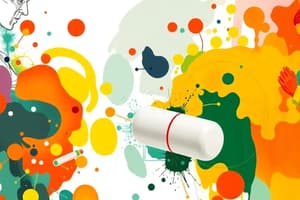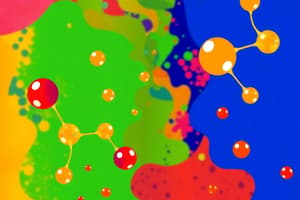Podcast
Questions and Answers
What type of water is suitable for parental use in pharmaceutical dosage forms?
What type of water is suitable for parental use in pharmaceutical dosage forms?
- Purified Water
- Potable Water
- Bacteriostatic Water
- Sterile Water for injection (correct)
Which of the following oils can be used for topical pharmacological applications?
Which of the following oils can be used for topical pharmacological applications?
- Castor Oil (correct)
- Coconut Oil
- Ethanol
- Benzyl Alcohol
Which excipient is primarily used to control the pH of a formulation?
Which excipient is primarily used to control the pH of a formulation?
- Buffer (correct)
- Viscosity Enhancer
- Sweetening Agent
- Density Modifier
What is the primary function of a preservative in pharmaceutical formulations?
What is the primary function of a preservative in pharmaceutical formulations?
Which of the following can be used as a sweetening agent in a pharmaceutical formulation?
Which of the following can be used as a sweetening agent in a pharmaceutical formulation?
What is the purpose of isotonicity modifiers in pharmaceutical solutions?
What is the purpose of isotonicity modifiers in pharmaceutical solutions?
Which excipient is used to enhance the viscosity of a pharmaceutical formulation?
Which excipient is used to enhance the viscosity of a pharmaceutical formulation?
Which of the following agents is known for its role in preventing oxidation in pharmaceutical formulations?
Which of the following agents is known for its role in preventing oxidation in pharmaceutical formulations?
Which of the following is a natural coloring agent?
Which of the following is a natural coloring agent?
What role does EDTA play among antioxidants?
What role does EDTA play among antioxidants?
Which sweetening agent is specifically noted for its use in diabetics?
Which sweetening agent is specifically noted for its use in diabetics?
Which agent is essential as a suspending agent in preparations?
Which agent is essential as a suspending agent in preparations?
What is a characteristic of a syrup as a liquid formulation?
What is a characteristic of a syrup as a liquid formulation?
Which of the following is an example of an evacuation enema?
Which of the following is an example of an evacuation enema?
Which wetting agent is commonly used with hydrophobic drugs?
Which wetting agent is commonly used with hydrophobic drugs?
What is the purpose of using a flocculating agent in suspensions?
What is the purpose of using a flocculating agent in suspensions?
Flashcards
Coloring Agents
Coloring Agents
Substances used to add color to pharmaceutical products.
Natural Coloring Agents
Natural Coloring Agents
Coloring agents derived from natural sources.
Synthetic Coloring Agents
Synthetic Coloring Agents
Coloring agents made in a laboratory.
Antioxidants
Antioxidants
Signup and view all the flashcards
Sweetening Agents (Natural)
Sweetening Agents (Natural)
Signup and view all the flashcards
Sweetening Agents (Synthetic)
Sweetening Agents (Synthetic)
Signup and view all the flashcards
Suspension Components
Suspension Components
Signup and view all the flashcards
Liquid Dosage Forms
Liquid Dosage Forms
Signup and view all the flashcards
Water as a vehicle in pharmaceuticals
Water as a vehicle in pharmaceuticals
Signup and view all the flashcards
Injectable water (WFI)
Injectable water (WFI)
Signup and view all the flashcards
Excipients in pharmaceutical formulations
Excipients in pharmaceutical formulations
Signup and view all the flashcards
Buffers in pharmaceutical formulations
Buffers in pharmaceutical formulations
Signup and view all the flashcards
Preservatives in pharmaceutical formulations
Preservatives in pharmaceutical formulations
Signup and view all the flashcards
Isotonicity in pharmaceutical formulations
Isotonicity in pharmaceutical formulations
Signup and view all the flashcards
Fixed oils in pharmaceuticals
Fixed oils in pharmaceuticals
Signup and view all the flashcards
Viscosity enhancers in pharmaceutical formulations
Viscosity enhancers in pharmaceutical formulations
Signup and view all the flashcards
Study Notes
Water as a Vehicle
- Potable water is not permitted for pharmaceutical dosage forms
- Purified water is used for aqueous oral and topical dosage forms
- Sterile water for injection (WFI) is used for parenteral preparations which should be free from dissolved gases.
- Examples include aminophylline injection
- Bacteriostatic water for injection used for multiple use, e.g., benzyl alcohol.
Aromatic Water
- Used as flavoring agents for children
- Examples include almond oil, phenol, glycerol, propylene glycol.
- Use for flavoring and sweetening.
- Internal (parenteral) use;
Otic Use
- Oils, such as castor oil, are used topically
- Coconut oil is used orally
- Wintergreen oil, turpentine oil, and peppermint oil are used for flavoring/perfumes
Alcohol
- Ethyl alcohol used externally for keratolytics, in Psoriasis, or warts.
- Propylene glycol and glycerol used internally and externally as preservatives and sweetening agents
Excipients
- Buffers control pH
- Density modifiers are used in spinal anesthetics
- Isotonicity is important for parenterals, ophthalmics, and nasals
- Viscosity enhancers increase viscosity
- Preservatives slow down bacterial growth
- Antioxidants are reducing agents that help prevent oxidation
- Sweetening agents are used
- Flavors and perfumes add taste
- Coloring agents provide color
Antioxidant
- Reducing agents and chelating agents are used as antioxidants
- Examples include BHT, BHA, ascorbic acid (vitamin C), tocopherol (vitamin E), sodium metabisulfite, and citric acid
- BHT is butylated hydroxy toluene
Sweetening Agents
- Natural sweetening agents include sucrose, glucose, honey and sorbitol, mannitol, and glycerol are used for diabetic patients.
- Synthetic sweetening agents include saccharin, aspartame, and sucralose.
Suspension
- Wetting agents for hydrophobic drugs
- Flocculating agents for suspensions
- Surface-active agents (e.g., Tween 80) are used
- Hydrophilic colloids such as acacia, tragacanth, and bentonite are used
- Solvents like alcohols and glycerin are used
- Structural vehicles such as sodium carboxymethylcellulose are used to suspend or thicken
Liq Dosage Forms
- Syrups (medicated or flavored)
- Elixirs (no need for preservatives, some examples are Dexamethasone or Phenobarbital)
- Linctuses
- Dry powders (e.g., penicillin V or cloxacillin)
- Solutions (e.g., for salicylic acid)
- Lotions
- Liniments (e.g., for methyl salicylate)
- Paints (for topical oral or dental applications, e.g., benzocaine, eugenol).
- Oral Spirits (flavoring agent)
Solutions in Body Cavities
- Rectal solution: e.g., aminophylline, hydrocortisone
- Retention enema
- Evacuation enema: e.g., magnesium sulfate
- Diagnostic enema: e.g., barium sulfate
Studying That Suits You
Use AI to generate personalized quizzes and flashcards to suit your learning preferences.




